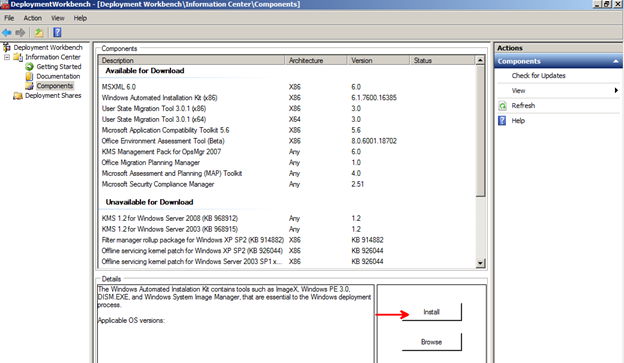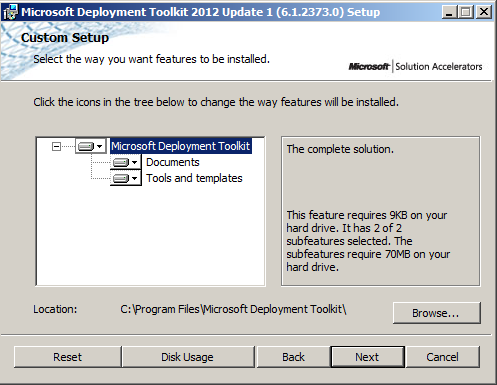Install The Mdt Extensions For Configuration Manager
To successfully deploy the Windows 10 operating system and applications for your organization, it is essential that you know about the available tools to help with the process. In this topic, you will learn about the most commonly used tools for Windows 10 deployment. Microsoft provides many tools, services, and solutions. These tools include Windows Deployment Services (WDS), the Volume Activation Management Tool (VAMT), the User State Migration Tool (USMT), Windows System Image Manager (Windows SIM), Windows Preinstallation Environment (Windows PE), and Windows Recovery Environment (Windows RE). Keep in mind that these are just tools and not a complete solution on their own. It’s when you combine these tools with solutions like or that you get the complete deployment solution.

If the ConfigMgr console is open, close it. In the Start Screen locate the Microsoft Deployment Toolkit group and click right click on Configure ConfigMgr Integration, choose Run as Administrator. Configure configmgr integration.png. Select the first option, Install the MDT extensions for Configuration Manager. Feb 25, 2016. Locate the newly installed Microsoft Deployment Toolkit application in the start menu, and expand it. Select and right click Configure ConfigMgr Integration, and Run as Administrator. Review the options, and select the radio button for Install the MDT extensions for Configuration Manager.

Posted at 18:50h in, by When it comes to OSD (Operating System Deployment), Microsoft has a several tools can help IT pros to accomplish, which always caused people confusing So what’s the difference between below 3 tools that Microsoft provided for us? Let’s start with a TechNet article called from Greg Shields who is a really good CBT Nuggets trainer (I’ve learnt a lot from him these years). As you can see from the above diagram, in today’s world, deploy an operating system is not like the “Ghost” age: golden image, clone,.gho file. Microsoft did a lot to separate the operating system into different layers, so now is much much easier to maintain and update. WDS (Windows Deployment Service) WDS act as a data transmission tool that didn’t do that much on the other customization level of the image.
WDS using the PEX boot your bare metal machine with Windows PE (Pre-installation Environment), similar to Ghost application, and capture or deploy an image to the computer. Nayagan Malayalam Songs Download. In the capture way, WDS will deploy a standard Windows to the computer, and then you can start doing the changes to the new/refresh computer, can capture it as your master image. In the deploy way, WDS will deploy any standard image or captured image to the new/refresh computer Another benefit for WDS is you can use WDS as the replacement for the traditional installation disc MDT (Microsoft Deployment Toolkit) MDT is an advanced tool can help people customize their image deployment. Such as inject the drivers into your image, install applications during the deployment, and even more MDT can works together with WDS for either a new bare metal computer or refresh an existing computer with your customized image, in this senerio, what we need from WDS is just the PEX boot MDT can only achieve what Microsoft called LTI ( Installation), which means user still need to interact with the installation process. Free Ringtone Download Directly To Phone Chuko Ji. SCCM (System Center Configuration Manager) SCCM can go even further with ZTI (Zero Touch Installation), which means there’s no user interaction during the system deployment, everything is automated and just ready to go when it’s done. Although you can always using unattended answer file to achieve the ZTI with WDS or MDT, but SCCM is still the most advanced tool can integrated with WDS and MDT to accomplish the most complicated deployment scenario. Both WDS and MDT is free of charge, but SCCM need a whole SCCM infrastructure before you can start the OS deployment.
So What I’m going to show you today is integrate my SCCM environment with MDT so we can start using the powerful tool to deploy our image 1. An running SCCM 2012 R2 environment 2. Install MDT 2013 Download the Microsoft Deployment Toolkit (MDT) 2013 installation files from Install on the SCCM site management server Install all the “Documents” and “Tools and templates” 3. Integrated MDT 2013 with SCCM 2012 R2 Confirm your “Site server name” and “Site code” 4. Verify the MDT task sequence in SCCM 2012 R2 Navigate to SCCM console->Software Library->Operating Systems->Task Sequence Now you should see the big “Create MDT Task Sequence” button like above 5. Install MDT 2013 and run “Configure ConfigMgr Integration” component” in all the computers that running the SCCM console with which you want to create MDT task sequence from. I have a workstation that running Windows 8.1, has all the administrative tools and console installed, which is my primary work place in my lab 6.
Start creating MDT task sequence.